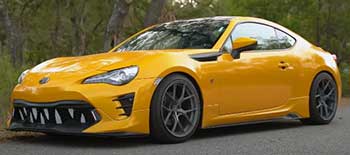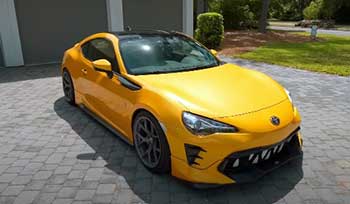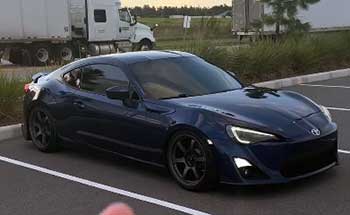
As a car enthusiast, I’ve always been drawn to sports cars that balance performance, style, and affordability.
The Toyota FT86 (also known as the Toyota 86 or GT86) and the Scion FR-S are two models that have sparked endless debates among gearheads like me.
My goal here is to break down their similarities, differences, strengths, and weaknesses, sharing my firsthand experiences to help you decide which one suits your driving style.
From design to maintenance, I’ll cover it all, giving you a clear picture of these iconic coupes.
Comparison Table: Toyota FT86 Vs. Scion FR-S
| x | Toyota FT86 (2012-2016) | Scion FR-S (2012-2016) |
|---|---|---|
| Engine | 2.0L 4-cylinder boxer, 200-205 hp | 2.0L 4-cylinder boxer, 200 hp |
| Transmission | 6-speed manual or 6-speed automatic | 6-speed manual or 6-speed automatic |
| Fuel Economy | 21/28 mpg (manual), 24/32 mpg (auto) | 22/30 mpg (manual), 25/34 mpg (auto) |
| Price (Used, 2025)* | $14,000-$18,000 | $13,000-$16,000 |
| Suspension Tuning | Slightly firmer, more aggressive | Softer, more balanced |
| Interior Features | Optional navigation, automatic climate control | Basic trim, fewer options |
| Exterior Styling | Aggressive front fascia, sharper lines | Sleeker, smoother design |
| Reliability | High, with minor recalls | High, with minor recalls |
| Cargo Space | 6.9 cubic feet | 6.9 cubic feet |
My Experience With Toyota FT86
When I first slid into the driver’s seat of a 2014 Toyota FT86, I felt an immediate connection. The low-slung cabin, the tactile grip of the steering wheel, and the responsive throttle made every drive feel like an event.
On a winding mountain road, the FT86’s rear-wheel-drive setup and sharp handling shone through, letting me carve corners with confidence. Its 2.0-liter boxer engine, producing 205 horsepower in later models, delivered enough punch to keep things exciting without overwhelming me.
The manual transmission was a joy, with short, precise throws that begged to be shifted.
However, the FT86 isn’t perfect. The cabin felt a bit dated, with hard plastics and minimal tech. On long highway drives, the engine’s drone could get tiresome, and the lack of low-end torque meant I had to work the gears to keep up with traffic.
Still, the car’s lightweight chassis and balanced dynamics made it a blast on backroads, where I could push its limits without breaking the bank on gas or maintenance.
The 2017 refresh, when the Scion FR-S became the Toyota 86, brought subtle improvements like LED taillights and better shock tuning.
I noticed the steering felt slightly more planted, especially during aggressive cornering. For me, the FT86’s charm lies in its simplicity—it’s a driver’s car, built for those who value feel over flash.
Pros Of Toyota FT86

- Affordable Performance: The FT86 offers thrilling rear-wheel-drive dynamics at a price that won’t empty your wallet, with used models in 2025 ranging from $14,000 to $18,000.
- Sharp Handling: Its low center of gravity and well-tuned suspension make it a corner-carving machine, perfect for enthusiasts who love spirited drives.
- Manual Transmission Option: The six-speed manual is crisp and engaging, letting you feel every gear change with precision.
- Reliable Engineering: Built with Toyota’s reputation for durability, the FT86 has minimal issues when properly maintained, with only minor recalls reported.
- Customization Potential: The aftermarket support for the FT86 is vast, from suspension upgrades to turbo kits, making it a favorite for tuners.
- Improved 2017 Model: The post-2016 refresh added subtle power bumps (205 hp for manuals) and better interior materials, enhancing the overall experience.
The FT86’s blend of affordability and performance is hard to beat. I’ve seen owners transform these cars into track beasts with simple mods, and the community support is incredible. Whether you’re a novice or a seasoned driver, the FT86 rewards skill and enthusiasm. Its sharp handling makes every corner feel like a playground, and the manual gearbox is a love letter to driving purists. For those who want a car that’s both practical and exhilarating, the FT86 delivers in a way few competitors can match at this price point.
Also read: My Thoughts on Acura ILX Vs. Honda Accord
Cons Of Toyota FT86
- Limited Low-End Torque: The 2.0-liter engine lacks punch below 4,000 RPM, requiring frequent downshifts to access power.
- Basic Interior: Hard plastics and minimal tech, like the lack of standard navigation in base models, make the cabin feel dated.
- Engine Noise: The boxer engine’s drone can be intrusive on long drives, especially without premium audio to mask it.
- Cramped Rear Seats: The back seats are more for show than function, barely fitting adults for short trips.
- Fuel Economy: At 21/28 mpg (manual), it’s decent but not stellar for a small sports car, especially compared to rivals like the Mazda MX-5 Miata.
- Limited Standard Features: Base models lack amenities like heated seats or advanced safety tech, which were optional or exclusive to higher trims.
The FT86’s weaknesses are noticeable but don’t overshadow its strengths. For me, the lack of torque was the biggest hurdle, especially when merging onto highways. Still, it’s a trade-off for the car’s lightweight, agile nature. The interior, while functional, lacks the polish of pricier competitors, and the rear seats are more of a joke than a feature. If you’re after luxury or raw power, you might look elsewhere, but for pure driving fun, these flaws are easy to forgive.
Maintenance Tips For Toyota FT86
- Regular Oil Changes: Use high-quality synthetic 0W-20 oil every 5,000-7,500 miles to keep the boxer engine running smoothly and prevent carbon buildup.
- Check Valve Springs: Early models (2012-2013) had valve spring recalls; ensure these were addressed to avoid engine issues.
- Monitor Tire Wear: The FT86’s sporty tires wear quickly with aggressive driving; rotate every 5,000 miles and replace with high-performance summer tires for optimal grip.
- Inspect Suspension: Bushings and shocks can wear under hard use; check for leaks or noise every 20,000 miles and replace with quality aftermarket parts if needed.
- Clean Air Filters: Replace the cabin and engine air filters every 15,000 miles to maintain performance and interior air quality.
- Brake Maintenance: Pads and rotors wear faster with spirited driving; inspect every 10,000 miles and upgrade to performance pads for better stopping power.
Maintaining an FT86 is straightforward, thanks to its Toyota reliability. I’ve found that keeping up with these basics keeps the car feeling fresh, especially if you push it hard on twisty roads or the occasional track day. The valve spring recall is a must-check for early models, as it can save you from costly engine repairs. Tires and brakes are the biggest wear items, but with proper care, they last longer than you’d expect for a car this fun to drive.
My Experience With Scion FR-S

The Scion FR-S was my first taste of the “Toyobaru” platform, and it left a lasting impression. Driving a 2013 model through city streets and open highways, I loved its sleek design and nimble handling. The 200-horsepower boxer engine felt lively, though it required high revs to shine.
The FR-S’s softer suspension compared to the FT86 made it a touch more forgiving over bumps, which suited my daily commute. Its minimalist interior, while basic, kept distractions low, letting me focus on the drive.
That said, the FR-S had its quirks. The lack of options like navigation or heated seats felt like a missed opportunity, especially in colder climates. The fuel economy, at 22/30 mpg (manual), was slightly better than the FT86, but I still wished for more low-end grunt.
When Scion was phased out in 2016, the FR-S became the Toyota 86, and I noticed the later models addressed some of these gripes with better tech and styling.
For me, the FR-S was a pure, no-frills sports car. It’s not about luxury or raw power—it’s about the joy of driving, and it delivers that in spades. The community around the FR-S is passionate, with forums buzzing with tips and mods to make it your own.
Pros Of Scion FR-S
- Lower Price Point: Used FR-S models in 2025 range from $13,000 to $16,000, making it a budget-friendly entry into sports car ownership.
- Balanced Handling: The softer suspension offers a smoother ride than the FT86, ideal for daily driving without sacrificing cornering ability.
- Sleek Styling: The FR-S’s smoother, less aggressive design appeals to those who prefer a cleaner, understated look.
- Fuel Efficiency: Slightly better mileage at 22/30 mpg (manual) and 25/34 mpg (auto) compared to the FT86, saving a few bucks at the pump.
- Reliable Platform: Like the FT86, the FR-S benefits from Toyota/Subaru engineering, with high reliability when maintained properly.
- Special Editions: Models like the 10-Series added unique colors and features like HID headlights, enhancing appeal for collectors.
The FR-S’s affordability and balanced ride made it a great first sports car for me. Its design still turns heads, and the driving experience feels raw and engaging. The special editions, like the 10-Series, add a touch of exclusivity without jacking up the price too much. For budget-conscious enthusiasts, the FR-S is a gateway to a vibrant car culture with endless customization options.
Cons Of Scion FR-S
- Minimal Features: Base models lack amenities like automatic climate control or navigation, feeling spartan compared to competitors.
- Weak Torque: Like the FT86, the 200-hp engine struggles at low RPMs, making it less responsive in everyday driving.
- Basic Interior: The cabin’s hard plastics and lack of premium materials can feel cheap, especially on long drives.
- Discontinued Brand: Scion’s phase-out in 2016 means parts and support may be harder to find compared to Toyota-branded models.
- Noisy Cabin: Engine and road noise are prominent, especially without a high-end audio system to offset it.
- Tight Rear Seats: The back seats are practically unusable for adults, limiting practicality for carrying passengers.
The FR-S’s simplicity is both its strength and weakness. I appreciated its focus on driving, but the lack of creature comforts occasionally frustrated me. The discontinued Scion brand can also make sourcing specific parts trickier, though Toyota’s support helps. If you prioritize driving dynamics over luxury, these cons are minor, but they’re worth considering for daily use.
Read more: My Thoughts on Acura Integra Vs. Honda Accord
Maintenance Tips For Scion FR-S
- Oil Changes: Stick to synthetic 0W-20 oil every 5,000-7,500 miles to ensure engine longevity, especially with frequent high-rev driving.
- Valve Spring Recall: Check if the 2012-2013 models had the valve spring recall fixed to prevent potential engine failure.
- Tire Maintenance: Rotate tires every 5,000 miles and opt for high-performance summer tires to maintain grip, as stock tires wear fast.
- Suspension Checks: Inspect shocks and bushings every 20,000 miles, as the FR-S’s softer setup can wear under aggressive use.
- Brake Care: Check brake pads and rotors every 10,000 miles; consider performance pads for better stopping power if tracking the car.
- Air Filter Replacement: Swap out engine and cabin air filters every 15,000 miles to keep performance and air quality optimal.
The FR-S is low-maintenance, but staying proactive keeps it running like a dream. I’ve found that regular checks prevent small issues from becoming costly repairs. The recall fix is critical for early models, and keeping tires fresh is key for maintaining the car’s grip. With basic care, the FR-S stays reliable and fun for years.
Comparison With Other Brands
- Subaru BRZ: The BRZ, a sibling to the FT86 and FR-S, offers similar performance but with slightly softer suspension tuning than the FT86. It has more trim options, like the Limited with heated seats, but costs slightly more ($14,000-$17,000 used).
- Mazda MX-5 Miata: The Miata is lighter and more agile, with better fuel economy (26/35 mpg), but its convertible design sacrifices practicality. It’s pricier used ($16,000-$20,000) but offers a different driving experience.
- Ford Mustang: The Mustang delivers more power (300+ hp) but feels heavier and less nimble. Its fuel economy (20/28 mpg) is worse, and used prices ($18,000-$25,000) are higher.
- Nissan 370Z: The 370Z’s V6 (332 hp) offers more grunt but guzzles gas (17/26 mpg) and feels less precise. Used prices ($15,000-$22,000) overlap with the FT86/FR-S.
- Hyundai Genesis Coupe: The Genesis Coupe has a stronger engine (348 hp in V6 models) but is less balanced and heavier. Used prices ($12,000-$18,000) are competitive, but reliability lags.
The FT86 and FR-S hold their own against these rivals, offering a unique blend of affordability, handling, and reliability. For me, their lightweight chassis and rear-wheel-drive setup make them stand out in a crowded field. The BRZ is the closest competitor, but its higher price and softer ride don’t always justify the cost. The Miata’s agility is tempting, but its lack of cargo space and higher price tag are drawbacks. The Mustang and 370Z offer more power but lose the nimble feel, while the Genesis Coupe’s reliability concerns make it less appealing. If you want a pure, engaging drive, the FT86 and FR-S are tough to beat.
Frequently Asked Questions (FAQ)
They’re nearly identical, built on the same platform with the same engine. The Toyota 86 replaced the FR-S after Scion’s discontinuation in 2016, with minor styling and suspension tweaks.
These cars share a joint Toyota-Subaru platform, with a Subaru-built boxer engine and Toyota-designed body. Branding and minor tuning differences cater to different markets.
Toyota phased out the Scion brand in 2016 to streamline its lineup. The FR-S was rebadged as the Toyota 86, receiving updates like more power and modern styling.
The AE86 (1980s Corolla) is a lightweight, rear-wheel-drive legend with a 1.6L engine, while the FR-S is a modern coupe with a 2.0L boxer engine, offering better tech and handling.
Conclusion: For Toyota FT86 And Scion FR-S Enthusiasts
You can’t go wrong with either the Toyota FT86 or Scion FR-S—they’re cut from the same cloth, delivering pure driving joy at a price that won’t break the bank. I’ve loved every moment behind the wheel of both, from the FT86’s aggressive edge to the FR-S’s sleek charm. If you crave sharper handling and a few extra features, the FT86 might be your pick.
If budget and a smoother ride matter more, the FR-S is a steal. Whichever you choose, you’re getting a reliable, fun sports car that’s a blast to drive and easy to maintain. So, what’s stopping you? Hit the road and feel the thrill for yourself.

